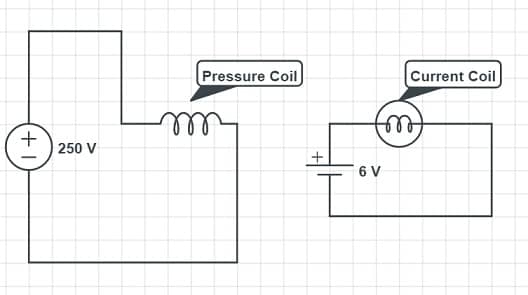Definition:
Phantom Loading is a loading condition in which an energy meter is connected to factious or phantom load for testing of energy meter with high current rating. Such loading is favorable to avoid wastage of energy during the test of measurement instrument.
Testing of energy meters are carried out to verify the actual registration as well as the adjustment done to bring the meter error within acceptable limit. An energy meter is subjected to various kind of test like Creep Test, Starting Test etc.
Phantom Loading Principle:
Pressure coil (PC) is connected across the source and Current coil in series with the load for the test purpose. In another words, we can say that meter is directly connected to the load. This is known as direct loading. Direct loading of meter for testing is only adopted where the current rating of meter is considerably low. This method of directly connecting the meter to the circuit leads to wastage of appreciable amount of energy when the current rating of energy meter is high. Therefore we must devise a new way to test energy meters having high current rating. Phantom Loading is that new way.
In Phantom Loading, the pressure coil is connected to the normal supply voltage and the current coil (CC) circuit is connected to a low voltage supply (phantom voltage). As the impedance of CC is low, therefore it is possible to circulate rated current through the CC with low voltage supply. The arrangement is shown below. In the figure value of voltages are just taken for example. These values will vary with rating of meter.
Under phantom loading condition, the total power required for this test will be sum of power loss in PC and CC. Mathematically, power required to carry out test is given as below.
= V2 / Rpc + VphIcc
where V = Normal rated voltage of meter
Rpc = Resistance of pressure coil
Icc = Rated current of energy meter
Vph = phantom voltage connected with current coil
Since Rpc is very high and Vph is very low (when compared with rated voltage of meter), therefore the total power required for the test under phantom loading will be very less. Let us now consider an example to better understand the facts discussed above.
Solved Examples on Phantom Loading:
Example: A 250 V, 5A DC Energy Meter is tested at its marked rating. The resistance of PC and CC are 8800 Ω and 0.1 Ω respectively. Calculate the power consumed when testing the meter with
1) Direct loading arrangement
2) Phantom loading with current circuit excited by a 6 V battery.
Solution:
Case-1: Direct Loading Arrangement
A schematic diagram for direct loading arrangement is shown below.
Power consumed in PC circuit = (250)2 / 8800
= 7.1 Watt
Power consumed in CC circuit = 250×5
= 1250 Watt
Total power consumed during test = 1257.1 Watt
(Don’t think that we are only calculating loss in CC rather we are calculating loss in whole CC circuit which includes load too. This is the reason we used VI for power calculation instead of using I2R as value of load resistance is not known.)
Case-2: Phantom Loading
The schematic diagram of phantom loading is given below.
Power consumed in PC circuit = (250)2 / 8800
= 7.1 Watt
Power consumed in CC circuit = 6×5
= 30 Watt
Total power consumed during test = 37.1 Watt
Carefully observe the results of case-1 & 2. You will notice that loss in PC circuit is not affected. But loss in CC circuit is now only around 2.5 % of loss under direct loading condition. This percentage reduction in loss in CC circuit is equal to the percentage of phantom voltage w.r.t. rated voltage i.e. (6 / 250) x 100 = 2.4 %. This means the lower the phantom voltage required to circulate the rated current in CC circuit, lower will be the power required for testing.



very well explained.